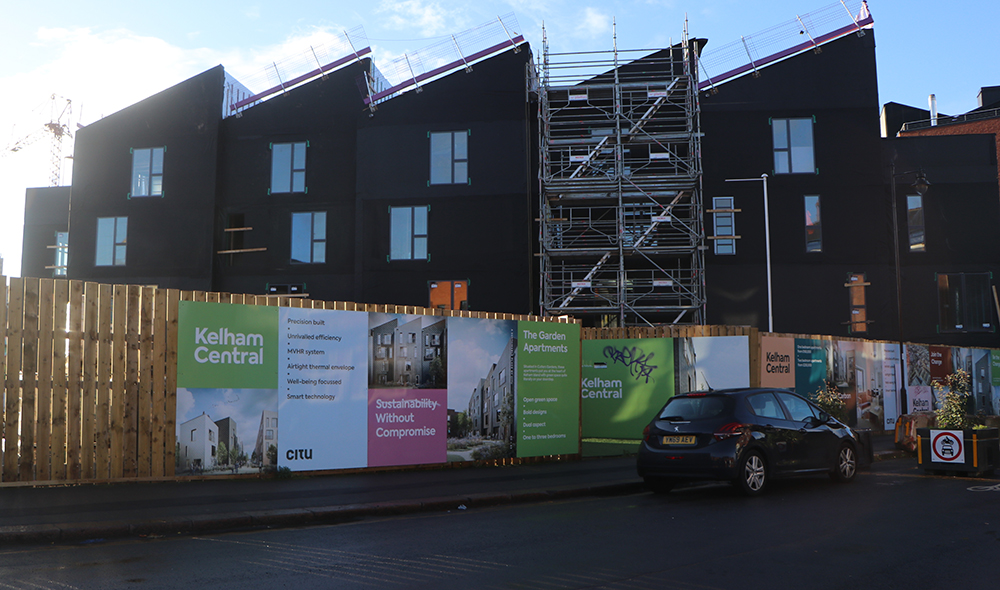Kelham Island is a tale of two cities. On the one hand, you have hipster-esque coffee shops, bars, barbers, and pubs – some charging a fiver for a pint, and on the other, you have buildings built in Sheffield’s industrial heyday that are now crumbling to pieces.
It used to be home to Sheffield’s industrial prowess, immortalised with the Kelham Island Museum, but is now more known for bars, underground clubs, food establishments, and housing.
The area has seen grand attempts at regeneration in the past decade, however after plans were recently announced to build a new seven-story flat building, the question of “Where is Kelham Island going?” has once again been raised.
On a Friday morning in Kelham, watching young professionals grab coffees before heading to work, it does feel as if its development has been quite disjointed – with more focus placed on some areas.
Parts of Kelham are neat, tidy, and welcoming whilst others are decrepit with smashed windows and an abundance of graffiti, where locals air their grievances at the development of the area. “This whole area has gone to s**t,” being particularly stinging.

Some of the graffiti to be found in Kelham
“We had a good run, didn’t we?” is perhaps one of the saddest pieces of graffiti to be seen in the area.

The new seven-story building has a design aiming at a net-zero carbon rating, and will also have a cycle shop, a hire & repair shop, a bakery, market deli, artists studio, and co-working spaces.
Katherine Jones, who lives in one of the flat buildings next to the museum, says it is a “lovely place to live” and she thinks the new businesses and flat buildings have been “great for the local economy”
Alp Ozan, a cafe and bar owner in Kelham, says he “thinks it’s obvious that this is designed to encourage the arts and cultural scene in the area because that’s what’s been missing in Kelham”
But Silas Hand, a Sheffield resident who often visits Kelham, disagrees and believes artists and creatives have been driven out of Kelham by developers.
“Artists and creatives move into an area because it’s industrial and edgy, developers see this and choose to swoop in, drive the prices up, and then those artists and creatives are forced to leave”, he says.
He adds that the artists and creatives “have been commodified.”
Mr Hand says that “the development has been useful in some ways, as it was quite a rejected area” but also that Kelham’s “usage has changed”.
He also highlights that prices have increased in recent years, and “everywhere is really expensive, apart from the Gardeners rest”.
A loving community
The Gardeners Rest is quite the hidden gem in Kelham, and a testament to the strength of the love for the area and local community. With an eclectically lit smoking area that looks out upon the Kelham Riverside, the community banded together to buy it after it was unofficially put onto the market for sale.
A small number of regulars established the Gardeners Rest Community Society with the aim of inviting like-minded people to invest in the society so that it could buy the pub and bring it into community ownership. It raised over double its £100,000 target and ended with a total of 382 investors donating £237,600, their website says.
Mr Hand continues that aside from the Museum, Kelham was never somewhere he really used to frequent until bars and cafes moved into the area, and he can “never really remember there being much residential space there”.
Residential spaces being built in the area has been one of the biggest changes of the past 10 years, with one of the most famous developments being Little Kelham.

The entrance to the Little Kelham housing development
The area for Little Kelham was acquired in 2012 by Yorkshire-based sustainable property developer Citu, whose aim was to create a low carbon development.
It uses triple-glazed windows, high standards of insulation, and air-tight building design to create zero-emission homes powered entirely by renewable electricity, according to the Citu website.
As of November 2021, every house (they are all between 1-3 bedrooms) in Little Kelham has been sold, and they are valued at an average of £228,144 according to Zoopla.
The Little Kelham scheme has also involved the regeneration of some key landmarks in Kelham Island, such as the Green Lane Works clock tower.

The Green Lane works clock tower
Residents have largely been sympathetic to the Kelham developments – as they have mostly kept Kelham’s unique industrial heritage.
One user on the Sheffield forum offers a positive opinion about the Little Kelham development: “Areas like the Little Kelham development have some of the most distinctive architecture in the city, the hospitality offering across the area is varied and popular, and generally I think it’s a well-kept collection of buildings and streets”.
Whilst another is less optimistic: “I give it another 20 years before it (Kelham Island) becomes another inner-city slum with associated problems”.
Some of the buildings and their owners have attempted to retain their original industrial look such as The Chimney House, a restaurant and events venue, and Church, Temple of Fun – which is owned by Sheffield band Bring Me The Horizon’s Oli Sykes and housed in the listed Osborn Works.
Osborn Works is the only industrial building designed by famed Victorian architect Willaim John Hale, who was responsible for some of the areas more iconic churches: “It’s only fitting that on the eve of the building’s 100th anniversary in 2018, it was reborn as Church, Temple of Fun,” says the website.
Another user on the Sheffield forum argues that despite all the new developments, Kelham is “still really run down.”
Mr Hand is overall grateful for the new developments in Kelham, but does not want people to be driven out of the area, as Kelham Island is all about the community and people, he warns.
“New developments can drive prices up and people out of the area, anything that forces people out of their communities is bad.”




